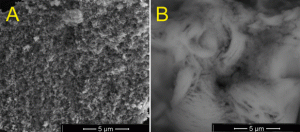Significant quantities of radioactive compounds are contaminating our environment. Due to nuclear weapon production during the Cold War, large quantities of radioactive Technetium-99 (99Tc) has been released into the environment. Although the Cold War ended 25 years ago, the total Tc inventory continues to rise as it is a major product during the generation of nuclear power resulting from the nuclear fission of uranium and plutonium.
Radioactive Tc is long lived and predominantly found in nuclear waste, in the highly mobile form of the water-soluble pertechnetate anion TcO4–. The high mobility possessed by TcO4– causes concerns regarding its distribution within the environment and makes storage impracticable within cement-based materials, a widely employed medium for the storage of nuclear waste.
Managing nuclear waste
Reduction of TcO4– from Tc(VII) to Tc(IV) is one possible solution. This is a challenging solution as Tc(IV) tends to convert back to TcO4– if exposed to oxygen. The reduction process requires a proton source to proceed and is disfavoured under the strongly alkaline conditions found in the waste media. The nuclear waste tanks also contain a large amount of both spectator ions, which make TcO4– more difficult to reduce, and high-valent metal species such as Cr(VI). This can interfere with the reduction process by consuming the available Sn(II) and/or by converting any formed Tc(IV) back to TcO4–.
To overcome these obstacles, Eric D. Walter and colleagues have devised a novel Tin(Sn)-based material which displays selective and efficient removal of Tc under conditions similar to those found in nuclear waste tanks. The approach taken relies on the inclusion of both Sn(II) and Sn(IV) within an inert aluminophosphate matrix. The low-valent form of tin is known for its ability of reducing Tc(VII) to Tc(IV), whereas the high-valent Sn(IV) was chosen for its ability to form SnO2 phases capable of accommodating the resulting Tc(IV) and thus facilitate its sequestration.
The material labelled Sn-Al-PO4 could be easily made from common laboratory chemicals and in this study was characterised by a number of analytical techniques investigating both the bulk and surface properties. It consists of two distinct phases:
- An amorphous Sn-based matrix containing the majority of the aluminium. This material has a large surface area and contains predominantly Sn(II), a combination of properties expected to yield efficient reduction of pertechnetate from the solution medium.
- Small embedded fibres of crystalline material with the composition dominated by Sn and phosphate.
The full article is free to access for a limited time only:
Inorganic tin aluminophosphate nanocomposite for reductive separation of pertechnetate Environ. Sci.: Nano, 2016, Advance Article
DOI: 10.1039/C6EN00130K
—————-
 About the webwriter
About the webwriter
Dan Mercea is a PhD student in the Fuchter group at Imperial College London. He is working on developing enantioselective FLP catalysis.
—————-
*Access is free until 19th October 2016 through a registered RSC account – register here











